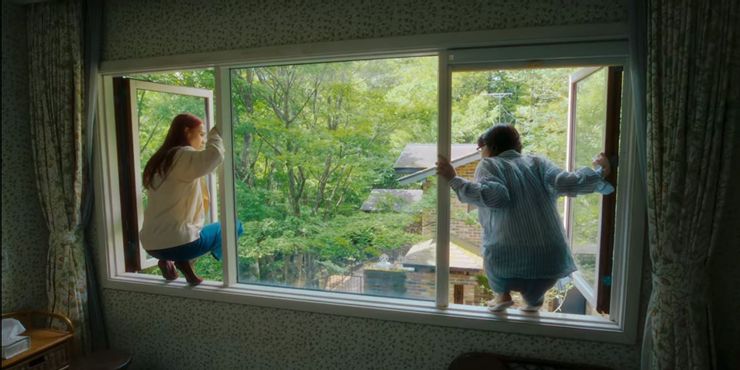Elena Goh reviews this complex and problematic Netflix produced Japanese psychological thriller about a toxic and intense lesbian couple.
“You smile when you lie,” Rei tells Nanae shakily, still dripping with Nanae’s husband’s blood. “And you look really cute when you do it. My entire life crumbles with just a single smile of yours.”
And so defines the turbulent relationship of these two characters throughout Ride or Die. The film, despite being advertised as a romance drama, is a psychological thriller directed by Ryuichi Hiroki and based on Nakamura Ching’s Gunjō (羣青), a cult lesbian manga known for its uniquely gritty art style. The story centres on the relationship between Rei Nagasawa (Kiko Mizuhara) and Nanae Shinoda (Hona Ikoka), two ex-highschool classmates now in their late twenties. Rei, upon learning that Nanae is being physically abused by her husband, decides to realise Nanae’s wish of murdering him to show her undying love for Nanae, who reciprocates by bringing her on a roadtrip as they escape from the police. Amidst flashbacks to their past, the film core is the tempestuous relationship they share, which oscillates between tender and downright abusive.

Lesbian films are rare in Japan, and it’s a plus to have greater representation in film, especially when it allows its leads to have complex, multi-layered characters and personalities beyond their sexuality. Kiko Mizuhara brings a touching performance of Rei’s dogged loyalty and determination to protect Nanae at the expense of herself, making her a sympathetic character even as she murders Nanae’s husband and runs from the law. On the other hand, Hona Ikoka brilliantly fleshes out both Nanae’s cruel, calculating nature, and her glass-shard vulnerability, bringing her character a enigmatic sense of unpredictability that is undeniably compelling to observe. Nonetheless, even the actresses’ stellar performances cannot mask how deeply problematic the film is, be that in its directing or its portrayal of lesbianism.
The overwhelmingly problematic nature of Ride or Die ultimately stems from the male gaze that looms over the film. From start to finish, the camera feels consistently voyeuristic, especially with regards to the bodies of the two main leads. There are several moments where gore and sexuality are intertwined in images of body horror — when Nanae reveals the bruises covering her body to show Rei the abuse she has suffered, when Rei stands naked in the shower with Nanae’s husband’s blood pouring down her skin — this may have been thought-provoking, were it not for the camera’s leering gaze. For a relationship thriller focusing on the psychologies of the two women, the film includes absurdly long, graphic, and frequent sex scenes that usually do not involve Nanae in any way, and I question the necessity of all the full-body shots of Rei. Worse still is the incredibly long lesbian sex scene between Rei and Nanae at the end of the film, which had an uncomfortably pornographic quality reminiscent of Blue is the Warmest Colour, except that both characters would take turns to discuss if they should commit suicide before continuing to make love. It’s no coincidence that every single male youtuber’s review of Ride or Die must mention how beautiful Rei is. The camera — panning up her legs, giving full-body shots in sex scenes, closing up on her face — makes sure that you remember.

Even this critique disregards the film’s general poor directing. To add to the drama, Ride or Die switches between shaky, serial killer-style close-ups and wide angle shots of road-trip scenery, too short to feel soothing and too long to actually be interesting. While the use of shaky handheld camera was probably intended to add tension to the film, it occurred so frequently and for such long takes that it became more annoying than anything else. The ditsy pop track of Che.R.R.y by YUI made for a sweet moment as Rei and Nanae reminisced over the music of their teenagehood, but otherwise the cheerful acoustic music that played after emotional scenes felt confusingly discordant and out-of-place.
Most disturbing, however, can be said to be the film’s treatment of lesbianism. Rei’s ex-girlfriend Mika Oe (Yoko Maki) provides a rare moment of sweet sincerity, especially in the scene where she accepts Rei’s departure without anger and trusts her to do the right thing (even though it really isn’t and Rei has no idea what she’s doing), but this is ultimately overshadowed by how dysfunctional the relationship between the two main leads is. It’s perfectly acceptable for LGBTQ characters to be flawed and morally grey — it gives them well-deserved space to be fully fleshed-out humans — but Rei and Nanae’s relationship joins a problematic trend of Japanese lesbian films situating themselves mostly in the horror or psychological thriller genres, portraying lesbianism as either an illicit affair or a form of twisted passion. This is especially perplexing in the context of the many wholesome lesbian couples in anime, and how many of those are situated in dystopian/thriller genres but still remain sincere portrayals of healthy relationships. The dynamic between the leads, however, is fueled by exploitation and manipulation. As high-school students, Rei exploits Nanae’s poverty to make her dependent, promising to pay her school fees in exchange for sex. As adults, Nanae exploits Rei’s love for her to murder her husband and get away scot-free. With the number of times Nanae leaves Rei pining and uses ‘stupid lesbian’ as an insult, audiences are left to question whether Nanae is even homosexual or simply using Rei’s affections as a literal ‘get-out-of-jail-free’ card. It is also immensely disturbing that the two heterosexual sex scenes in the film both involve Rei, a woman largely characterised by her lesbian relationships, and both times are used to show how abusive and immoral men are towards her.

In the end, Rei’s self-sacrifice allows her to gain some form of agency over the narrative, allowing her to save Nanae while giving herself a chance to explain her perspective to the press, who have already labelled her as a ‘crazy prostitute’. Nanae shows sincere care for her for the first time as well, and the film ends with a reflection of their high school potraits. While this scene is meant to be touching, the continued toxicity and abuse in their relationship detracts viewers from feeling moved and, honestly, I just felt relieved that they would be separated and unable to abuse each other anymore
As a whole, Ride or Die is less uncomfortable if viewed with the expectation that it is a thought-provoking psychological thriller, focusing on the dysfunctional relationship between two very flawed and complex women. However, as LGBTQ representation and (as the Netflix trailer suggests) an intense romance between lesbians who would kill for each other, it is deeply problematic film.
Ride or Die streaming on Netflix:




